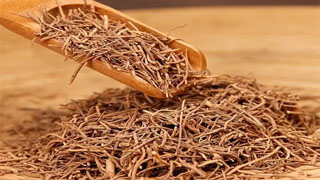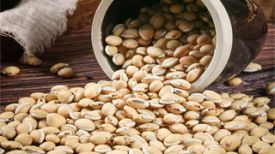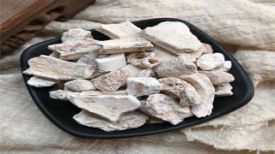
1. Alias
Ghost Inspector Post, Farewell to the Immortal, Earthly Asarum, Bamboo with Material Claw, One Arrow, Three Hundred Arrows.
2. Plant morphology
Perennial upright herb, up to 1 meter tall, with fine roots in the shape of tendrils, up to more than 50, and a special odor. The stem is unbranched, hairless or slightly hairy. Leaves opposite, papery, lanceolate to linear, sharply pointed at both ends, hairless on both sides or sparsely furry on the upper surface, slightly curled with eyelashes at the leaf margin. The inflorescence of the conical umbrella is axillary near the top, with more than 10 flowers, and the inner surface of the calyx may or may not have glands. The corolla is yellow green, nearly radial, with lobes up to 4 millimeters long and 3 millimeters wide, and 5 sub corolla lobes. The top is blunt, the base is thickened, and there is one pollen block per chamber. It droops, the arms are short, and it is flat. The ovary is elliptical, the stigma is pentagonal, and the top is slightly raised. Fruit pods. The seed is oblong, about 3 millimeters long, with white silky seed hairs at the top, and 1 centimeter long.
3. Origin distribution
Born in the grass on a sunny slope. Distributed in Heilongjiang, Jilin, Liaoning, Inner Mongolia and other places.
4. Harvesting and processing
In summer and autumn, dig whole grass, tie it into small bundles, remove impurities, and air dry or sun dry it. For medicinal roots and rhizomes, remove the above ground parts. When processing, remove impurities and wash slightly, cut into small pieces, and dry in the shade.
5. Characteristics of medicinal herbs
The rhizome is irregularly cylindrical with nodes, measuring 0.5-3.5 centimeters in length and 2-4 millimeters in diameter, surrounded by many slender roots. The root is cylindrical, curved, 10-11 centimeters long, 1-1.5 millimeters in diameter, with a light brown or light brownish yellow surface, fine longitudinal wrinkles, and slender fibrous roots. Crispy in texture, easily breakable, powdery in cross-section, yellow white in phloem, light brown in cambium ring, small and pale yellow in xylem, with a Danpi aroma and a slightly pungent taste.
6. Sexual Taste Returning to the Classics
Warm in nature, pungent in taste. Return to the liver meridian and stomach meridian.
7. Effect and Function
Dispelling wind and dampness, promoting qi circulation and unblocking meridians. Belonging to the category of wind dampness dispelling drugs, it is a strong muscle and bone dispelling medicine.
8. Clinical application
Dosage of 3-12 grams is used to treat rheumatism, rheumatism, bloating, toothache, dysmenorrhea, and swelling and pain caused by falls. Used in combination with Polygonum multiflorum and other ingredients to lower blood lipids; This product treats various skin diseases; Making this product into an injection to treat pain caused by various reasons has achieved certain effects; Water decoction or tablets have better therapeutic effects on simple chronic bronchitis, but poorer effects on wheezing type; This product, together with ass hide glue and madder, has a good effect in treating chronic aplastic anemia.
9. Pharmacological research
Has sedative, analgesic, and antipyretic effects; Can lower blood pressure, resist myocardial ischemia, and prevent arrhythmia; Reduce blood fat and anti atherosclerosis; Inhibit platelet aggregation and prevent thrombosis; Anti inflammation and anti allergy; Reduce ileal tension and inhibit gastrointestinal motility; Has inhibitory effects on liver microsomal metabolism and uterine contractions; Anti early pregnancy effect. Xu Changqing extract (excluding the main component of paeonol) and paeonol have been proven to have analgesic effects on mice using the hot plate method (writhing reaction), and intraperitoneal injection of paeonol has sedative effects on mice; The decoction has a certain antibacterial effect; Danpi phenol has anti-inflammatory and anti allergic effects; Cynanchum paniculatum or paeonol can regulate blood lipid and prevent atherosclerosis. Toxicity: Xu Changqing extract was administered intraperitoneally, and the LDso in mice was (32.93 ± 1.03) g/kg; The LDso of paeonol is 381 grams per kilogram.
10. Chemical composition
This product mainly contains paeonol, isopaeonol, carnitine glycoside, paeonol glycoside, 2-hydroxy-6-methoxyacetophenone, dephenolated cowhide glycoside, Xuchangqing glycoside A, Xuchangqing glycoside B, Xuchangqing glycoside C, Xinxuchangqing glycoside F, Xuchangqing polysaccharide, etc.
11. Usage taboos
It should not be fried for a long time, and those who are weak should take it with caution.
12. Compatibility prescription
① Treating rheumatic pain: 24-30g of Xu Changqing root, 120g of pork red meat, and 60g of aged wine. Boil half a bowl with water, take before meals, twice a day. (Fujian Folk Herbal Medicine)
② Treatment for chronic back pain: 9 grams each for Xu Changqing and Tiger Cane, and 5 grams for Red Four Tiles. At the end of the research. Take 0.6-1 grams each time, 2-3 times a day, and swallow with warm water. (Hubei Journal of Chinese Herbal Medicine)
③ Treatment for cold and abdominal pain: 9 grams of Xu Changqing and 6 grams of fennel. Fry and serve. (Anhui Chinese Herbal Medicine)
④ Treating external swelling and pain: Fresh Xu Changqing roots, raw Gardenia jasminoides, and equal amounts, crushed and applied externally; Add 9 grams of Xu Changqing, boil in water, and mix with an appropriate amount of yellow wine when taking. (Anhui Chinese Herbal Medicine)
⑤ Treatment of blood deficiency and meridian obstruction: Take 6-9g of Xu Changqing, stew sweet wine or meat for internal consumption, or grind and swallow 3g. (Guizhou Folk Herbs)
⊙ The content of the article is for clinical reference only. Non TCM professionals are not allowed to test drugs.


